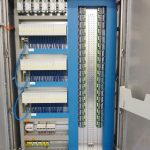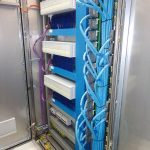Anyone who avidly follows the technology and IT press would have already read the swan songs to the smartphone that went around a few years ago. Even well-respected CEOs from Silicon Valley have recently predicted that its time had come. Data glasses, smartwatches and digital assistants, such as Amazon’s Echo with its assistant Alexa, as well as similar devices are often mentioned as successors. Technology migration makes space for new innovations – one characteristic that the consumer and industrial B2B business have in common. When existing device types are discontinued or become unnecessary, their function, i.e. what they performed for a plant or machine, has
to be taken over by a different device.
Brownfield projects in the chemical industry can also be considered in the same way. At petrochemical company Chevron Phillips Chemicals International NV, Turck’s Excom today replaces the previous I/O system and the Ex isolation in the same housing. This creates space in the I&C room for plant expansions and for innovative technologies. The plant in Beringen belongs to Chevron Phillips Chemicals International (CPChem) since the end of 2011. It was founded in 1991 by the Finnish refinery Neste. The Beringen plant focuses on the manufacture of polyalphaolefins (PAO), which are used in synthetic oils and lubricants. These oils are primarily used in the automobile industry and other industrial sectors.
When in 2013 the Finnish manufacturer discontinued the I/O system used in the control cabinets in Beringen for the Honeywell control systems, the engineers in charge at CPChem looked for alternatives for the I/O system used. They looked for a system that could be linked to the Honeywell control system via Profibus DP and provide the Ex isolation of the signals, i.e. supply both intrinsically safe and non-intrinsically safe devices. It also had to be a flexible system that supported the latest in diagnostic functions and open standards. The new I/O level also had to take up as little space as possible and not affect the availability of the plant.
CPChem first of all asked Honeywell whether they could recommend suitable I/O systems to replace the existing system. Honeywell gave its recommendations, which included Excom. Several projects worldwide already testify to the excellent collaboration between Honeywell and Turck – equally in terms of the collaboration between their employees and the interaction between systems used.
Pilot project
CPChem first of all rolled out a pilot project with one control panel, in which the I/O cards were replaced with an Excom rack. This was for the intrinsically safe signals for field devices in Zone 1 or 2. As the pilot project proved to be successful, follow-on projects with Excom were planned. Initial finding of the pilot project: Excom saves a lot of space. Other systems require a separately located Ex isolation for the signals in Zone 1. With Excom, signal processing and Ex isolation are integrated in a single housing. After the pilot project, it was clear to CPC that they only required three control cabinets with Excom to replace five control cabinets with devices of the old system.
After the successful pilot project, CPChem replaced a total of 172 I/Os in 2015. This time, the space benefits of Excom were fully utilised. The replacement of the I/O cards was planned so that entire control cabinets became unnecessary. This space is now available for plant expansions or the installation of additional technology. In the follow-on project in 2017 other I/O cards for 720 signals were connected via Excom.
Connection to the control system
The time available for installing the I/O technology was short. Although the Beringen plant has a turnaround with a length of maximum 14 days every two years, more than just the physical installation had to be completed within this time frame. The new devices also had to be commissioned and their interaction with the overall system thoroughly tested.
It was a great advantage that Turck could supply fully prewired control cabinets, which were fitted with both Excom and special marshalling panels that CPChem
had previously used. Turck’s own service provider for custom solutions, Turck
Mechatec, assembled the control cabinets prewired and ready to connect with the marshalling panels. This considerably shortened the installation time for CPChem since it was possible to retain all the field cabling.
A service provider for CPChem just had to erect the control cabinets and connect the cables to the correct terminals. “A lot of preparation work could be done in advance. This was a considerable benefit. We were able to work by plug and play as we did not have a lot of time. The actual installation only took one to two days. However, the tests still had to be carried out afterwards,” explained engineer Sarah Gyssels, who
also described the site acceptance test (SAT) and factory acceptance test (FAT). While the FAT was carried out at Turck Mechatec prior to installation, the site acceptance test had to be carried out in the plant after the installation. This often takes longer than the actual installation itself.
One system for all signals
The entire migration of the I/O cards for the non-intrinsically safe signal has to be completed by 2019. By then, all the 2000 I/Os will be connected through Excom. The fact that all signals, whether intrinsically safe or not, are connected via the same system also makes it simpler for operators. Excom for Zone 1, 2 or the safe area use the same GSD file and the same DTM. Employees therefore only have to become acquainted with one logic and user interface to operate the system. Although Hart communication is not currently used by CPChem, the Hart capability of Excom is important in order to be equipped for later innovations.
Unlike many other systems, the individual channels of a module are galvanically isolated. In the event of external interference, such as through electromagnetic waves, this ensures that this interference is not also transferred to neighbouring channels. This makes measuring ultimately more reliable. Short circuits on a module channel also do not have any negative effects on the other channels of the same module.
Online search: cppPC218turck













